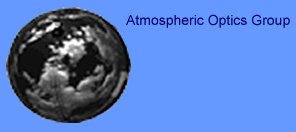
 |
| |
|
|
|
|
|
|
|
Laser Markers for 3D Cloud Height DistributionWe have consulted with various research teams regarding use of pairs of imagers to determine 3D cloud distributions. If a cloud or cloud feature can be simultaneously identified in each of two images acquired a reasonable distance apart, and the angular properties of the imagers are known, then the angles in space for the corresponding pixels may be determined, and the cloud height derived. More importantly, if this correspondence can be determined over the full field of view, then cloud height can automatically be determined over the full overlapping field of view of the two instruments. (This technique is sometimes identified as “stereoscopy”.) One of the challenges is that if the base length between the two imagers is too small, the uncertainty in height determination becomes quite large. However, if the base length is too large, then the cloud morphology is too different from the two sensors – ie, the clouds look different from two different positions, and it becomes difficult to identify the correct mapping. Sophisticated image processing algorithms are being developed at research locations, which attempt to identify the cloud pixel correlation from one image to the other in a complex cloud field. Clearly, errors in the resulting mapping can result in significant errors in the cloud height determination. At MPL, we evolved the idea of using a laser to illuminate or mark the clouds at one or more points, in order to provide a clear spot in the images. This would provide a point at which the image correlation can be unambiguously determined. Then cloud pixel correlation over the rest of the image should be far more straightforward and acccurate, particularly if several cloud marks are used. This should make determination of the mapping or registration of the two images far less prone to significant error. The laser would be directed by a WSI, and would be sensed by a second
receiver. The largest challenge is having sufficient light from the laser
to be detected against the cloud background by a compatible sensor. We
believe that new developments in lasers have now made this practical.
Although we consider the specific technology to be proprietary at this
time, our early calculations and tests indicate that this could be done
both night and day. The technique would be most cost-effective at night,
and would reach the highest cloud altitudes at night. However, initial
tests indicate that using a laser marker is also practical for low and
mid-level cloud during the day.
Produced
by the Marine Physical Laboratory, SIO.
|